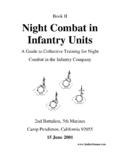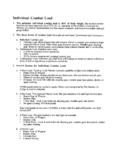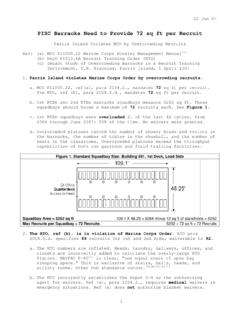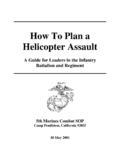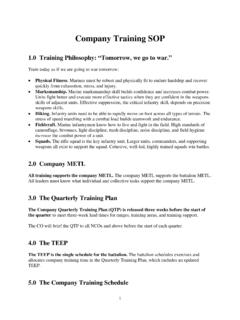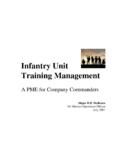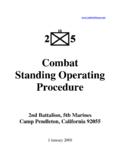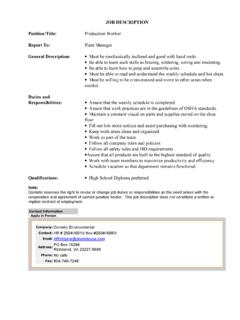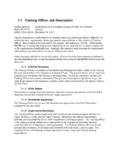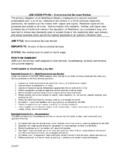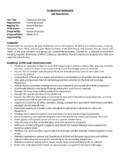Transcription of Combat Squad Leader’s Course Billet Description: …
1 C:\mydocu~1\ 5 May 98 Combat Squad Leader s Course Billet Description: infantry Squad Leader A Draft Proposal for inclusion in MCO MCWL 5 May 1998 c:\mydocu~1\ 5 May 98 UNITED STATES MARINE CORPS Marine Corps Warfighting Lab Marine Corps Combat Development Command Quantico, Virginia 22134 5 May 1998 From: Capt Brendan B. McBreen To: Director, MCWL Subj: PROPOSED CHANGE TO MCO : infantry Squad LEADER Billet DESCRIPTION 1. The MOS Manual, MCO (5 Apr 95), contains no duty descriptions for infantrymen. The manual states For a complete listing of duties and tasks, refer to MCO 2. MCO , The Individual Training Standards for Occupational Field 03, contains no duty descriptions either. It merely lists training tasks required for each rank. There is no prioritization. There are no stated minimum requirements.
2 3. FMFM 6-5 Marine Rifle Squad does not contain a comprehensive description of the duties of the rifle Squad leader. 4. This document attempts to fill this gap. The following draft Squad leader Billet description is proposed for inclusion into MCO 5. A Billet description serves the following purposes: a. Defines the requirements for promotion. A Marine should be competent in his current Billet before being considered for promotion. b. Defines the school curriculum. A Squad leader Course teaches those skills required by the Squad leader Billet description. Both units and schools refer to a common reference, which resolves differences of opinion. c. Guides training and evaluation. Marines can train and prepare for their next Billet . Units can train future leaders . Commanders have a baseline by which to measure a Marine s performance.
3 C:\mydocu~1\ 5 May 98 Billet Description Squad Leader of the Rifle Squad , Rifle Platoon, Rifle Company 1. This Billet description is third in a series of six for the Rifle Platoon: a. Rifleman Includes Rifleman, Assistant Automatic Rifleman, and Automatic Rifleman b. Fire Team Leader c. Squad Leader d. Platoon Sergeant e. Platoon Commander 2. Billet descriptions (a) through (d) are cumulative. This Billet description defines the skills required of all infantry Squad leaders . It shows only those skills which are required in addition to those of the Fire Team Leader, which in turn show only those skills required in addition to those of the rifleman. 3. This Billet description does NOT include the required training expected of every Marine. Because it applies to all infantry units, it does NOT include specialized skills expected of units preparing for specific missions.
4 4. Each skill is acquired at either a formal school or within the infantry battalion. For infantry Squad leaders , the formal school is the Squad Leader Course , SOI(E) and SOI(W). Skills are coded in one of two ways, ether a letter or a numeral. a. P for Proficient, is an introductory proficiency below the standard. S for Standard, indicates trained to standard. b. For those skills for which a standardized numeric level has been set by training order, the standard code is used. Refer to the specific MCO for detailed explanations. (1) Land Navigation Qualification. MCO XXXX. (2) Swim Qualification. MCO XXXX. (3) Rifle Qualification. MCO XXXX. (4) Physical Fitness Test. MCO XXXX. (5) Physical Readiness Tests. MCO XXXX. (6) NBC Qualification. MCO XXXX. (7) Annual First Aid and Health Qualification. MCO XXXX. (8) Tactical Communications Qualification.
5 MCO XXXX. c. The above orders define the proficiency levels: 1-3 5. Contents. This Billet description is divided into three parts. c:\mydocu~1\ 5 May 98 a. Part 1 Squad Leader Description b. Part 2 Squad Leader Skills Outline c. Part 3. Squad Leader Task List. 6. Purpose. This Billet description is intended to be used by those responsible for training to decide priorities and design syllabi and programs. 7. Units should ensure that this Billet description is read and understood by all potential Squad leaders and thereafter is readily available to them for reference. 8. Any person wishing to propose amendments to this order is invited to write to MCWL, MCCDC, Quantico, Virginia 22134. c:\mydocu~1\ 5 May 98 Table of Contents Part 1. Squad Leader Description How does the Squad fight on the battlefield of the 21st century?
6 Who leads the Squad in the 21st century? What are the implications for change? Part 2. Squad Leader Skills Outline 1. Individual Skills Squad Weapons Squad Equipment Squad Tactics Supporting Fires Land Navigation First Aid and Health NBC Fitness Communications 2. Training Skills Instructional Techniques Squad Weapons Squad Equipment Squad Tactics Communications First Aid NBC Navigation Fitness Training Patrolling Helicopter Operations 3. Combat Command Skills General Offensive Operations Defensive Operations MOUT Patrolling Helicopter Operations Other Tactical Operations Military Operations Other Than War (MOOTW) Noncombatants 4.
7 Administrative Skills General Part 3. Squad Leader Task List c:\mydocu~1\ 5 May 98 Part 1. Squad Leader Description 1. How does the Squad fight on the battlefield of the 21st Century? Since its inception from the island campaigns in the Pacific during WWII, the 13-man Marine rifle Squad has been and will remain the basic Combat maneuver unit of the future. No change will to its basic organization is foreseen. It is an ideal formation for maneuver warfare, a doctrine seeks to exploit the initiative of small units on the battlefield. However, as the modern battlefield becomes more lethal and less crowded as the firepower of ever smaller units rises, the relative import of the rifle Squad will also increase significantly. Improved communications have now allowed coordination and targeting between widely separated units.
8 Additionally, as the attempts to deal with rouge nations and non-state actors, the Marine Corps Squad may increasingly find themselves fighting unconventional enemies in highly ambiguous situations. Thus, the modern rifle Squad , a unit of substantial Combat power, must be capable of operating independently across wider areas on this decentralized and nonlinear battlefield of the next century. The Squad still attacks, defends, infiltrates, patrols, and serves as an integral part of the next larger unit the platoon. However, experiments have shown that the Squad can operate independently on the deep, noncontiguous battlefield, using supporting fires as its primary weapon. Furthermore, the Squad can operate semi-independently on the urban battlefield, physically close to other squads, yet separated by the urban terrain. The Squad mans the roadblock, distributes the humanitarian aid, pacifies the village, or secures the warehouse.
9 In ambiguous conflicts, the Squad distinguishes between combatants and noncombatants and is the primary user of the ROE. Due to dominance in sensors, communications, and weapons lethality, conflict will increasingly occur in close, complex environments, especially urban, to negate technological advances. The Squad fights at bayonet point in these instances. 2. Who Leads the Squad in the 21st Century? The Squad Leader is the primary warfighter in the Marine Corps. For the Marine Corps to institutionalize maneuver warfare and realize the potential of this doctrine, the infantry Squad leader must be extensively trained and educated. I m the most important leader on the battlefield. If I fight well, we win. If not, you, Captain, cannot do your job! The Squad Leader recognizes that he is the primary warfighter and that his actions can win battles.
10 This aggressive, self-confidence is based on his experience, his training , his tactical education, and the focus of the Marine Corps on producing outstanding small unit infantry leaders . The Squad Leader is a tactician. In Combat , the Squad leader commands his unit and any attached units. He directs supporting fires direct fires from company and battalion units, and indirect fires from company, battalion and MAGTF levels. The Squad leader knows the tactical fundamental of Marine Corps doctrine, and how his unit fits into the context of the larger fight. He understands and can execute decentralized and independent operations. He knows how the enemy fights. He knows how reconnaissance, surveillance and intelligence contribute to his commander s decision needs. The Squad leader is a combined arms warrior. He knows how to integrate his own Squad weapons with the platoon, company and battalion.
